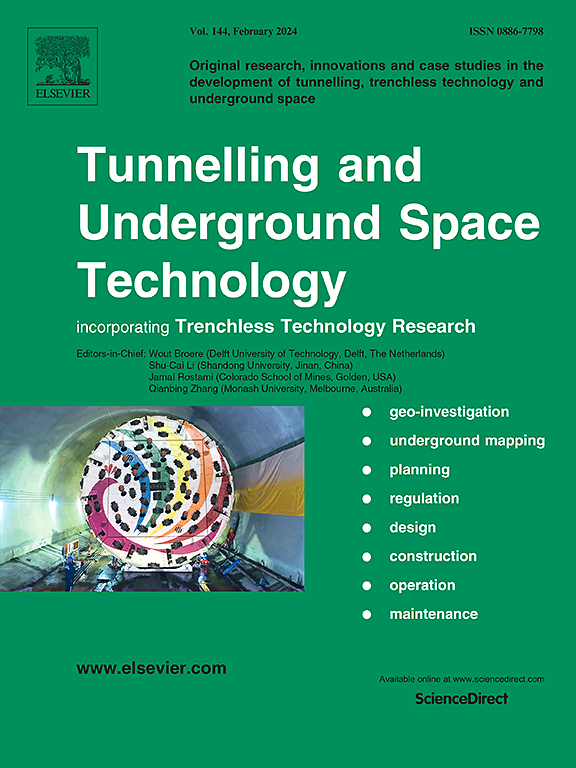The pressure field inside water-rich cracks of tunnel linings during high-speed train passing through tunnels using air–water two-phase flow simulation
IF 7.4
1区 工程技术
Q1 CONSTRUCTION & BUILDING TECHNOLOGY
引用次数: 0
Abstract
Water-rich cracks are a common type of damage in high-speed railway tunnels. When high-speed trains passing through tunnels, the dramatic changing in aerodynamic pressure repeatedly acts on water-rich cracks, potentially causing further crack expansion or even more severe structural damages. This study employs the dynamic overlapping grid method and the volume of fluid (VOF) model to establish a multiphase flow coupling model of air-train-tunnel-water-rich cracks, analyzing the spatiotemporal variation characteristics, influencing factors, and mechanisms within water-rich cracks when a high-speed train passes through a tunnel. The main conclusions are as follows: (1) The pressure changes inside the water-rich cracks exhibit a significant pressure amplification phenomenon. Compared to the tunnel wall, the increase in positive peak value (Cp,max) and negative peak value (Cp,min) of the aerodynamic pressure near the crack tip is as high as 22.91 % and 51.71 %. (2) The pressure variation trend along the length direction inside the water-rich crack has a distinct one-dimensional feature, while along the depth direction is significantly different. The pressure waves do not change with depth of the crack in water-free section, but the pressure fluctuation amplitude in the water-rich section increases with the depth. (3) The positive and negative pressure waves exert thrust and suction forces on the water body inside the water-rich crack, leading to fluctuation in air density near the crack tip, thus causing oscillation and amplification in the pressure. The water in the water-rich cracks exhibits increased motion amplitude and peak acceleration with greater depth, causing the pressure in water also intensifies. (4) Compared to those outside the crack at 300 km/h, the Cp,max near the water-rich crack tip increased by 6.69 %, 77.98 %, and 62.03 % when the train speed is 300 km/h, 350 km/h, and 400 km/h, and the Cp,min increased by 57.71 %, 111.25 %, and 161.73 %, respectively. The maximum pressure fluctuation amplitude occurring at a water content of 80 %. The results can provide theoretical basis for the healthy and high-quality operation of high-speed railway tunnels.
利用气-水两相流模拟高速列车通过隧道时隧道衬砌富水裂缝内的压力场
富水裂缝是高速铁路隧道中常见的一种损伤类型。当高速列车通过隧道时,空气动力压力的剧烈变化反复作用于富水裂缝,可能导致裂缝进一步扩大甚至更严重的结构损伤。本研究采用动态重叠网格法和流体体积(VOF)模型建立了空气列车-隧道-富水裂缝多相流耦合模型,分析了高速列车通过隧道时富水裂缝内的时空变化特征、影响因素及机理。主要结论如下:(1)富水裂缝内部压力变化表现出明显的压力放大现象。与隧道壁面相比,裂缝尖端气动压力的正峰值(Cp,max)和负峰值(Cp,min)分别增加了22.91%和51.71%。(2)富水裂缝内部压力沿长度方向变化趋势具有明显的一维特征,而沿深度方向变化趋势差异显著。无水断面压力波不随裂缝深度变化,而富水断面压力波动幅值随深度增加而增大。(3)正负压波对富水裂纹内部的水体施加推力和吸力,导致裂纹尖端附近空气密度波动,从而引起压力振荡和放大。富水裂缝中的水随着深度的增加,运动幅度增大,峰值加速度增大,导致水中压力增大。(4)列车速度为300 km/h、350 km/h和400 km/h时,富水裂纹尖端附近的Cp、max和min分别比裂缝外增大了6.69%、77.98%和62.03%,Cp和min分别增大了57.71%、111.25%和161.73%。在含水量为80%时出现的最大压力波动幅度。研究结果可为高速铁路隧道的健康、高质量运营提供理论依据。
本文章由计算机程序翻译,如有差异,请以英文原文为准。
求助全文
约1分钟内获得全文
求助全文
来源期刊

Tunnelling and Underground Space Technology
工程技术-工程:土木
CiteScore
11.90
自引率
18.80%
发文量
454
审稿时长
10.8 months
期刊介绍:
Tunnelling and Underground Space Technology is an international journal which publishes authoritative articles encompassing the development of innovative uses of underground space and the results of high quality research into improved, more cost-effective techniques for the planning, geo-investigation, design, construction, operation and maintenance of underground and earth-sheltered structures. The journal provides an effective vehicle for the improved worldwide exchange of information on developments in underground technology - and the experience gained from its use - and is strongly committed to publishing papers on the interdisciplinary aspects of creating, planning, and regulating underground space.
 求助内容:
求助内容: 应助结果提醒方式:
应助结果提醒方式:


